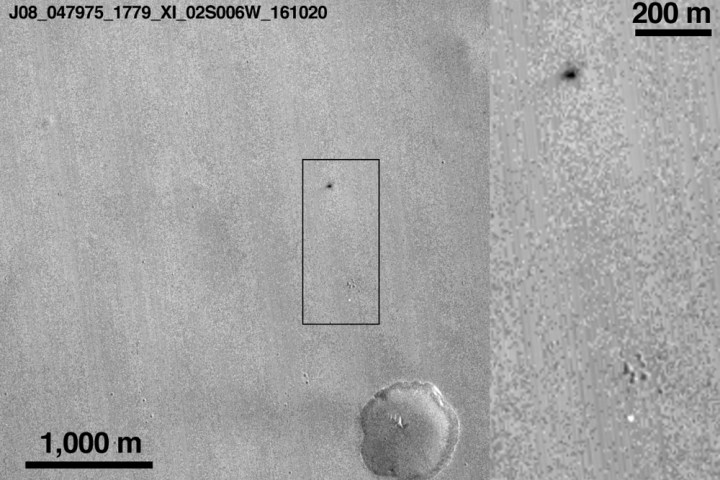
And now, one month later, we know why. According to the European Space Agency, the crash landing occurred after a computer misjudged the spacecraft’s altitude, causing the lander to fly directly into Mars at a speed of 335 miles per hour. The ESA noted that the spacecraft’s computer software led it to believe it was lower than it really was, and consequently, it deployed its parachute and braking thrusters earlier than needed.
“The erroneous information generated an estimated altitude that was negative — that is, below ground level,” the ESA said in a statement. “This in turn successively triggered a premature release of the parachute and the backshell [heat shield], a brief firing of the braking thrusters and finally activation of the on-ground systems as if Schiaparelli had already landed. In reality, the vehicle was still at an altitude of around 3.7 km (2.3 miles).”
In the days after the ExoMars experienced its unfortunate landing, NASA has been collecting and analyzing surface photos taken by the Mars Reconnaissance Orbiter using the vessel’s low-resolution CTX camera. NASA worked with the ESA to record the descent of the lander as part of the planned mission. The images are believed to show the entry, the descent via parachute, and the subsequent landing of the spacecraft. The final images show a broad, dark patch, approximately 50 by 130 feet in dimensions, that is thought to show the impact and possible destruction of the Schiaparelli module on landing.
The ESA’s recent statement confirms an earlier hypothesis, which suggested that the module crashed when its thrusters were turned off prematurely. Instead of floating to a soft landing using thrusters, the lander dropped up to 2.5 miles at a speed of 184 mph. If the thrusters were not operational, then the module would have crash landed with a full load of fuel. The fuel would have exploded on impact, producing the large cloud of surface debris that was seen on the MRO footage.
“In some ways, we’re lucky that this weakness in the navigation system was discovered on the test landing, before the second mission,” ESA’s Schiaparelli manager, Thierry Blancquaert, said.
“This is still a very preliminary conclusion,” added David Parker, ESA’s director of human spaceflight and robotic exploration. “The full picture will be provided in early 2017 by the future report of an external independent inquiry board.”
“But we will have learned much from Schiaparelli that will directly contribute to the second ExoMars mission being developed with our international partners for launch in 2020.”
Article originally published in October. Updated on 11-24-2016 by Lulu Chang: Added news of why the ExoMars lander crashed.
Editors' Recommendations
- NASA’s InSight lander detects ‘monster quake’ on Mars
- European Space Agency suspends joint Mars mission with Russia
- Why NASA is about to cut contact with its Mars explorers
- Watch the European Space Agency test its Mars rover parachute
- NASA’s Ingenuity helicopter travels 160 meters in 8th Mars flight



